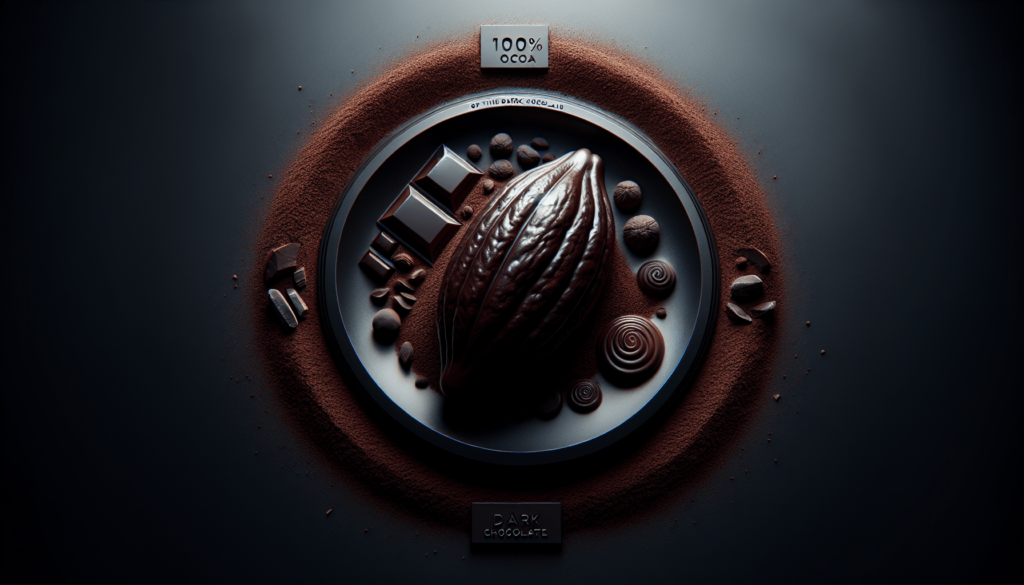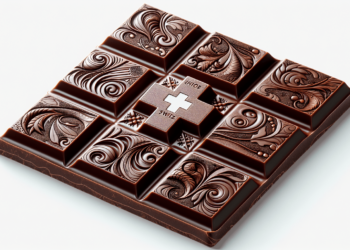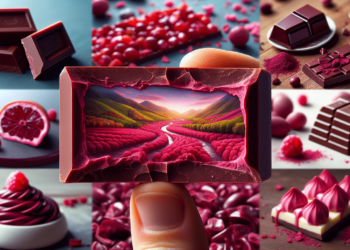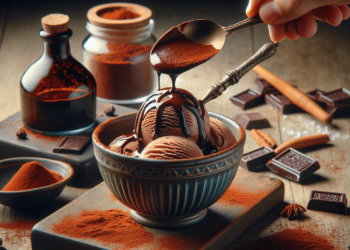Are you a cocoa lover who can’t resist the rich and intense flavor of dark chocolate? Then you might have wondered – is 100 cocoa the same as dark chocolate? Well, get ready for a delicious revelation as we unravel the mystery behind these two heavenly treats. While 100 cocoa may sound similar to dark chocolate, there are some key differences that make them distinct. So, grab a sweet treat and join us as we explore the wonders of cocoa and dark chocolate!

What is 100 Cocoa?
Definition of 100 Cocoa
100 Cocoa refers to a type of chocolate that is made using 100% cocoa bean or cocoa mass. It is essentially the purest form of chocolate available, containing no other additives or ingredients apart from cocoa solids. This makes it incredibly rich and intense in flavor, with a strong and slightly bitter taste. 100 Cocoa is often used as a base ingredient for various chocolate products, as well as in baking and cooking.
Cocoa Content in Chocolate
Cocoa content refers to the percentage of cocoa bean or cocoa mass present in a chocolate product. It is an important factor in determining the quality and flavor profile of chocolate. The higher the cocoa content, the more intense and robust the chocolate flavor will be. Different types of chocolate, such as milk chocolate, dark chocolate, and 100 Cocoa, have varying cocoa content. While milk chocolate typically contains around 10-50% cocoa, dark chocolate has a higher cocoa content, ranging from 50% to 100%. 100 Cocoa, as the name suggests, has a cocoa content of 100%.
Understanding Dark Chocolate
Definition of Dark Chocolate
Dark chocolate is a type of chocolate that has a higher percentage of cocoa solids and a lower sugar content compared to milk chocolate. It is known for its rich, deep, and complex flavor profile, making it a favorite among chocolate enthusiasts. Dark chocolate can vary in terms of cocoa content, ranging from 50% to 100%. The higher the cocoa content, the more intense and bitter the flavor will be.
Cocoa Content in Dark Chocolate
Dark chocolate is characterized by its high cocoa content, which sets it apart from other types of chocolate. The cocoa content in dark chocolate typically ranges from 50% to 100%, with higher percentages indicating a stronger chocolate flavor. Some popular variants of dark chocolate include 70%, 85%, and 90% cocoa content. The cocoa content is an essential factor to consider when choosing dark chocolate, as it directly influences the taste and intensity of the chocolate.
Health Benefits of Dark Chocolate
Dark chocolate has gained popularity not only for its delicious taste but also for its potential health benefits. Dark chocolate is rich in antioxidants, such as flavonoids, which are known to have various health benefits. Consuming dark chocolate in moderation may contribute to lower blood pressure, improved heart health, and reduced risk of certain chronic diseases. Additionally, dark chocolate contains minerals like iron, magnesium, and copper, which are beneficial for overall well-being.
Flavor Profile of Dark Chocolate
Dark chocolate’s flavor profile is often described as intense, rich, and slightly bitter. The higher the cocoa content, the more pronounced the bitterness becomes. The taste of dark chocolate can vary depending on the origin and quality of the cocoa beans used, as well as the processing methods employed. Some dark chocolates may have fruity or floral notes, while others may exhibit earthy or nutty undertones. Exploring different brands and cocoa percentages can help you discover your preferred flavor profile within the realm of dark chocolate.
Differences Between 100 Cocoa and Dark Chocolate
Cocoa Content
The primary difference between 100 Cocoa and dark chocolate lies in their cocoa content. 100 Cocoa contains 100% cocoa bean or cocoa mass, making it the purest form of chocolate available. On the other hand, dark chocolate can have a cocoa content anywhere between 50% to 100%, with variations in flavor and intensity depending on the specific percentage chosen.
Processing Methods
In terms of processing methods, 100 Cocoa and dark chocolate may differ. Dark chocolate undergoes a process that includes roasting, grinding, and refining the cocoa beans to produce cocoa solids, cocoa butter, and sugar. 100 Cocoa, on the other hand, involves minimal processing, with the cocoa beans being ground into a fine powder without the addition of any other ingredients.
Ingredients
Another notable difference between 100 Cocoa and dark chocolate lies in their ingredients. 100 Cocoa contains only one ingredient – cocoa beans. Dark chocolate, on the other hand, typically includes additional ingredients such as sugar, cocoa butter, and sometimes vanilla. These ingredients help balance the intense flavor of the cocoa and provide a smoother texture to the chocolate.
Sugar Content
Since 100 Cocoa consists solely of cocoa beans, it contains no added sugar. Dark chocolate, however, usually contains varying amounts of sugar, depending on the brand and cocoa percentage. As the cocoa content increases, the sugar content generally decreases, resulting in a more robust and less sweet flavor profile.
Texture
The texture of 100 Cocoa and dark chocolate can differ as well. 100 Cocoa is usually in the form of a fine powder, making it easy to incorporate into recipes and drinks. Dark chocolate, on the other hand, can have a range of textures, depending on its cocoa content and manufacturing process. Higher cocoa content dark chocolates tend to have a more firm and dense texture, while lower cocoa content dark chocolates may be smoother and creamier.
Similarities Between 100 Cocoa and Dark Chocolate
Cocoa Origin
One similarity between 100 Cocoa and dark chocolate is that they both originate from cocoa beans. Cocoa beans are sourced from cacao trees found in various regions, such as West Africa, South America, and Asia. The quality of the cocoa beans and their origin greatly influence the flavor profile and characteristics of both 100 Cocoa and dark chocolate.
Health Benefits
Both 100 Cocoa and dark chocolate offer potential health benefits due to their high cocoa content. The antioxidants and minerals present in cocoa can have positive effects on cardiovascular health, brain function, and overall well-being. However, it is important to consume them in moderation as part of a balanced diet.
Nutritional Value
Both 100 Cocoa and dark chocolate contain essential nutrients and minerals, such as iron, magnesium, and copper. They also provide a source of dietary fiber. However, it is worth noting that dark chocolate, especially those with higher cocoa content, generally has a higher nutritional value due to its less processed nature and the absence of added ingredients such as sugar and milk solids.

Uses of 100 Cocoa
Baking
One of the primary uses of 100 Cocoa is in baking. Its intense cocoa flavor adds depth and richness to baked goods such as cakes, cookies, and brownies. This pure cocoa powder is often used in recipes that call for a strong chocolate presence, allowing bakers to control the sweetness and flavor profile of their creations.
Hot Chocolate
100 Cocoa is also commonly used to make hot chocolate. By mixing the cocoa powder with hot milk or water and sweetening it to taste, you can create a rich and luxurious hot chocolate beverage that showcases the pure essence of cocoa.
Cocoa Powder Drinks
In addition to hot chocolate, 100 Cocoa can be used to make a variety of cocoa powder drinks. From indulgent mochas to flavorful chocolate smoothies, the intense cocoa flavor adds a delicious twist to any beverage.
Uses of Dark Chocolate
Eating
One of the most enjoyable uses of dark chocolate is simply eating it as a snack. The rich and complex flavor of dark chocolate can be savored on its own, offering a satisfying and indulgent treat for chocolate lovers.
Baking
Similar to 100 Cocoa, dark chocolate is commonly used in baking as well. Its intense flavor and unique characteristics make it a popular choice for creating decadent cakes, cookies, and desserts.
Cooking
Dark chocolate can also be used in cooking savory dishes. It can be melted into sauces, incorporated into chili or mole recipes, or used as a coating for meats or vegetables to add depth and complexity to the dish.
Culinary Applications
Dark chocolate’s versatility extends to various culinary applications. It can be grated or shaved to garnish desserts, melted into ganache or truffles, or used as a key ingredient in ice cream and sorbets. The distinct flavor of dark chocolate adds a luxurious touch to a wide range of culinary creations.
Choosing Between 100 Cocoa and Dark Chocolate
Personal Preference
Choosing between 100 Cocoa and dark chocolate ultimately comes down to personal preference. If you prefer a more intense and pure cocoa flavor, 100 Cocoa is the ideal choice. However, if you enjoy a balance of cocoa flavor and sweetness, dark chocolate with a suitable cocoa percentage may be more suitable.
Recipe Requirements
Consider the specific recipe requirements when choosing between 100 Cocoa and dark chocolate. Some recipes may call for the intense flavor of 100 Cocoa, while others may benefit from the more complex flavor profile of dark chocolate. It’s important to choose the option that best complements the overall taste and texture of the dish.
Texture Preferences
Texture can also play a role in the decision-making process. If you require a smooth and creamy texture, dark chocolate may be the preferred choice. However, if you prefer a powdery texture, 100 Cocoa will better suit your needs.
Health Considerations
When weighing your options, consider the health benefits as well. Both 100 Cocoa and dark chocolate offer potential health benefits, but dark chocolate with higher cocoa content generally provides a greater antioxidant and nutritional boost. However, always consume them in moderation as part of a balanced diet.
Popular Brands and Products
Well-Known 100 Cocoa Brands
Some popular brands that offer 100 Cocoa products include Valrhona, Guittard, and Lindt Excellence. These brands are known for their high-quality cocoa powder, which is often favored by professional bakers and chocolatiers.
Popular Dark Chocolate Brands
There are numerous reputable dark chocolate brands available in the market. Some well-known brands include Ghirardelli, Lindt, and Green & Black’s. These brands offer a wide range of dark chocolate options, allowing you to find the perfect balance of flavor and cocoa content.
Product Recommendations
For those looking to explore the world of 100 Cocoa and dark chocolate, some recommended products include Valrhona Pure Cocoa Powder for baking, Lindt Excellence 85% Dark Chocolate for a rich and intense flavor, and Green & Black’s Organic Dark Chocolate for a more approachable yet still indulgent experience. Experimenting with different brands and flavors will help you discover your personal favorites.
Storage and Shelf Life
Proper Storage of 100 Cocoa
To ensure the freshness and quality of 100 Cocoa, it is important to store it properly. It should be kept in an airtight container in a cool and dry place, away from direct sunlight and moisture. When stored correctly, 100 Cocoa can have a shelf life of up to two years.
Proper Storage of Dark Chocolate
Dark chocolate should be stored in a cool and dry place, ideally at a temperature between 60-68°F (15-20°C). It is best to store it away from strong odors to prevent any flavor absorption. Dark chocolate should also be kept away from direct sunlight, as exposure to heat and light can cause it to melt or develop a white “bloom” on the surface. When stored properly, dark chocolate can maintain its quality for up to one year.
Shelf Life of 100 Cocoa
The shelf life of 100 Cocoa can vary depending on the brand and storage conditions. It is important to check the manufacturer’s guidelines for specific recommendations. Generally, when stored in an airtight container in a cool and dry place, 100 Cocoa can maintain its quality for up to two years.
Shelf Life of Dark Chocolate
The shelf life of dark chocolate can also vary depending on the brand and cocoa content. Higher quality dark chocolates with a higher cocoa content tend to have a longer shelf life. When stored properly, dark chocolate can maintain its quality for up to one year.
Conclusion
Summary of Differences
In summary, the key differences between 100 Cocoa and dark chocolate lie in their cocoa content, processing methods, ingredients, sugar content, and texture. 100 Cocoa is a purer form of chocolate with a cocoa content of 100%, while dark chocolate typically has a cocoa content ranging from 50% to 100%. 100 Cocoa undergoes minimal processing and contains only cocoa beans, while dark chocolate includes additional ingredients such as sugar and cocoa butter. The sugar content in 100 Cocoa is zero, while dark chocolate can have varying amounts of sugar. 100 Cocoa is a fine powder, whereas dark chocolate can have various textures depending on its cocoa content.
Considerations when Choosing
When choosing between 100 Cocoa and dark chocolate, consider your personal preference, recipe requirements, texture preferences, and health considerations. Both options have their own unique characteristics and uses, so it’s important to choose the one that best suits your needs and desired flavor profile.
Enjoying the Flavors
Whether you prefer the intense purity of 100 Cocoa or the rich complexity of dark chocolate, both options offer a world of flavors to be enjoyed. From baking to snacking, there are endless possibilities for incorporating these chocolate delights into your culinary creations. So indulge in the flavors, savor the taste, and discover the joy of chocolate in its purest and most delectable forms.





